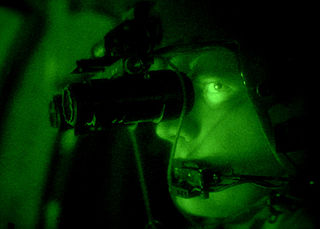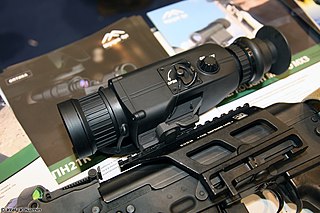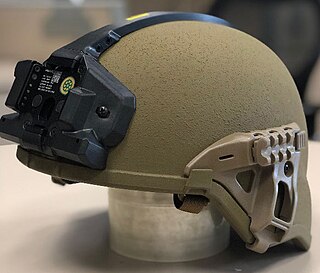
Night vision is the ability to see in low-light conditions, either naturally with scotopic vision or through a night-vision device. Night vision requires both sufficient spectral range and sufficient intensity range. Humans have poor night vision compared to many animals such as cats, foxes and rabbits, in part because the human eye lacks a tapetum lucidum, tissue behind the retina that reflects light back through the retina thus increasing the light available to the photoreceptors.

A night-vision device (NVD), also known as a night optical/observation device (NOD), night-vision goggle (NVG), is an optoelectronic device that allows visualization of images in low levels of light, improving the user's night vision. The device enhances ambient visible light and converts near-infrared light into visible light which can be seen by the user; this is known as I2 (image intensification). By comparison, viewing of infrared thermal radiation is referred to as thermal imaging and operates in a different section of the infrared spectrum. A night vision device usually consists of an image intensifier tube, a protective housing, and may have some type of mounting system. Many NVDs also include a protective sacrificial lens, mounted over the front lens (ie. objective lens) on NVDs to protect the latter from damage by environmental hazards and some can incorporate telescopic lenses. The image produced by an NVD is typically monochrome green, as green was considered to be the easiest color to look at for prolonged periods in the dark. Night vision devices may be passive, relying solely on ambient light, or may be active, using an IR (infrared) illuminator to better visualize the environment.

The M24 Sniper Weapon System (SWS) or M24 is the military and police version of the Remington Model 700 rifle, M24 being the model name assigned by the United States Army after adoption as their standard sniper rifle in 1988. The M24 is referred to as a "weapon system" because it consists of not only a rifle, but also a detachable telescopic sight and other accessories.
An image intensifier or image intensifier tube is a vacuum tube device for increasing the intensity of available light in an optical system to allow use under low-light conditions, such as at night, to facilitate visual imaging of low-light processes, such as fluorescence of materials in X-rays or gamma rays, or for conversion of non-visible light sources, such as near-infrared or short wave infrared to visible. They operate by converting photons of light into electrons, amplifying the electrons, and then converting the amplified electrons back into photons for viewing. They are used in devices such as night-vision goggles.
The Special Operations Peculiar MODification (SOPMOD) kit is an accessory system for the M4A1 carbine, CQBR, FN SCAR Mk 16/17, HK416 and other weapons used by United States Special Operations Command (USSOCOM) special forces units, though it is not specific to SOCOM. The kit allows US Special Operations Forces personnel to configure their weapons to individual preferences and customize for different mission requirements.

The Lightweight Helmet (LWH), also known as the Lightweight Marine Corps Helmet or Lightweight Marine Helmet, is an armored helmet that is used by the United States Marine Corps and U.S. Navy. It is the U.S. Marine Corps' replacement for the PASGT combat helmet and is derived from the Modular Integrated Communications Helmet.

The AN/PVS-14 Monocular Night Vision Device (MNVD) is in widespread use by the United States Armed Forces as well as NATO allies around the world. It uses a third generation image intensifier tube, and is primarily manufactured by Litton Industries and Elbit Systems of America. It is often used 'hands free' using a head harness or attached to a combat helmet such as the PASGT, MICH TC-2000 Combat Helmet, Advanced Combat Helmet, Marine Lightweight Helmet or IHPS. It can also be used as a weapons night sight. In addition, it was part of the equipment fielded in the U.S. Army's Land Warrior program. Morovision Night Vision was the law enforcement distributor of the NEPVS-14 for ITT.

A thermographic weapon sight, thermal imagery scope or thermal weapon sight is a sighting device combining a compact thermographic camera and an aiming reticle. They can be mounted on a variety of small arms as well as some heavier weapons.
F-INSAS is India's programme to equip its infantry with state-of-the-art equipment, F-INSAS standing for Future Infantry Soldier As a System. However the Indian Army has decided to drop the F-INSAS program in favour of two separate projects. The new program will have two components: one to arm the future infantry soldier with the best available assault rifle, carbines and personal equipment, such as helmets and bulletproof vests. The second component is the Battlefield Management Systems (BMS).

AN/PVS-4 is the U.S. military designation for a specification of the first second generation passive Night vision device.

The Enhanced Combat Helmet (ECH) is a combat helmet designed in conjunction of a joint program of the United States Marine Corps and United States Army to replace the current combat helmets in use by the U.S. Army, Air Force, Navy, and Marines. Although similar in shape of the Advanced Combat Helmet and its predecessor the Modular Integrated Communications Helmet, the ECH instead is constructed using thermoplastics instead of the ballistic fibers used on the previous generation combat helmets.

The M2010 Enhanced Sniper Rifle (ESR), formerly known as the XM2010 and M24 Reconfigured Sniper Weapon System, is a sniper rifle developed by PEO Soldier for the United States Army. It is derived from and replaced the M24 Sniper Weapon System, and was designed to give snipers longer range in the mountainous and desert terrain of the War in Afghanistan. After winning a competitive bidding process, Remington was awarded the production contract for up to 3,600 weapons. The Army had anticipated sending the upgraded weapons to deployed snipers in late 2010, but later expected fielding would happen in January 2011. The M2010 fires .300 Winchester Magnum (7.62×67mm) ammunition, which offers about 50 percent more effective range than the M24's 7.62×51mm NATO. This chambering to dimensionally larger cartridges is possible because the M24 was designed to use the "long action" bolt version of the Remington 700 receiver for cartridges up to 3.34 inches (84.84 mm) in overall length.

The AN/PVS-7 is a single tube biocular night vision device. Third-generation image intensifiers are able to be installed and are standard for military night vision. Most newer PVS-7 intensifier tubes are auto-gated to prevent image intensifier damage if exposed to intense light. The goggles have a built-in infrared Illuminator for low-light situations. They are waterproof and charged with nitrogen to prevent internal condensation while moving between extreme temperatures.
The AN/PVS-5 is a dual-tube night-vision goggle used for aviation and ground support. It uses second-generation image-intensifier tubes. The United States Army still has PVS-5 on supply but are very rarely used. The AN/PVS-5 is based on the SU-50 which was a first-generation night-vision goggle adapted by the United States Air Force in 1971. From 1972 until 1990 the AN/PVS-5 was the mainstay in US Army night vision for aviation. The AN/PVS-5C was not approved for flight because of its auto-gated feature causing the goggle to shut off in bright light. For ground troops the AN/PVS-5 was the sole night-vision goggle until the adaptation of the improved AN/PVS-7. Photographic evidence from Operation Eagle Claw shows US military personnel at Desert One in Iran using in the AN/PVS-5 NVGs.

The AN/PVS-17 Miniature Night Sight (MNS) is a compact, lightweight and high performance night vision weapon sight in wide use by the United States Special Forces and United States Marine Corps (USMC). The AN/PVS-17 is a Generation III Night Vision Device and uses the OMNI IV MX 10160 3rd generation image intensifier tube and can also be used as a handheld observation device. The designation AN/PVS translates to Army/Navy Portable Visual Search, according to Joint Electronics Type Designation System guidelines.

The Integrated Head Protection System (IHPS) is the United States Army's newest combat helmet, intended to eventually replace the Advanced Combat Helmet and Enhanced Combat Helmet.

The Integrated Visual Augmentation System (IVAS) is a augmented reality headset being developed by Microsoft for the United States Army, providing a wide variety of new capabilities to soldiers. Originally developed for infantry, it is also being adapted for use by mounted soldiers and aircrew. Its development was initiated in 2018 and is currently undergoing testing.

The AN/PSQ-42 Enhanced Night Vision Goggle-Binocular (ENVG-B) is a third-generation passive binocular night vision device developed for the United States Army by L3Harris. It combines dual tube image-intensifying (I²) and thermal-imaging technologies into a single goggle, enabling vision in low-light conditions. The two methods can be used individually or simultaneously in a fused mode. The ENVG-B is intended to be issued to the dismounted combat arms soldiers within the Army's Brigade combat teams (BCT), and so far over 10,000 have been issued to several BCT's within the 1st Infantry Division, 2nd Infantry Division, 25th Infantry Division, 82nd Airborne Division and 101st Airborne Division. The US Marine Corps has also purchased 3,100 ENVG-B units.














